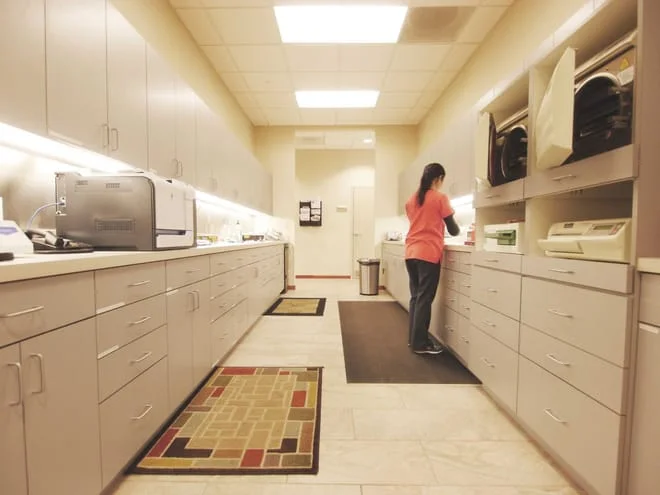
Our office uses state of the art sterilization to ensure patient safety.
Sterilization and disinfection are the basic steps in instrument processing
and surface asepsis. Sterilization refers to the use of a physical or
chemical procedure to destroy all forms of microorganisms, including the
highly resistant spores.
We use Rapid Steam Autoclave at 275º F(35psi), for 15-20 minutes
First, the instruments are prepared for the sterilization process. Patient
debris and fluids are removed by placing the instruments in 3.2%
glutaraldehyde for 40 minutes .Following this pre-disinfection step the
instruments are transferred to an ultrasonic cleaner for another 15 minutes
.Then the instruments are rinsed, dried, placed in self sealing
sterilization pouches and sterilized in the autoclave. Instruments which can
not be heat sterilized, are immersed in 2% glutaraldehyde for 10 hours to
cold sterilize.
We use Biological, Chemical and Mechanical indicators to monitor our
sterilization process.
Using bacterial spores to monitor the sterilization process is referred to
as biologic monitoring (or spore-testing), and the bacterial spores used for
monitoring the sterilization process are referred to as biologic indicators
(BIs). Of the three methods, biologic monitoring is regarded as the most
valid for monitoring the sterilization process, for it uses live, highly
resistant bacterial spores.
We biologically monitor our sterilizer once a week to ensure complete
sterilization using spore strips and keep accurate records for our
monitoring. These strips are enclosed in a glassine envelope and processed
through the sterilizer. They are then sent to our spore testing center where
they are tested for live spores.
Chemical monitoring involves using chemical indicators (CIs) that change
color or form when exposed to specific high temperatures or to the
sterilizing conditions within a sterilizer. This is referred to as chemical
monitoring (or process monitoring). We use sterilization pouches that have
special marking that change color when subjected to sterilizing
temperatures.
Mechanical monitoring involves observing and recording the physical aspects
(e.g., temperature, pressure, or time) of the cycle when the sterilizer is
being operated. Our Sterilizer is serviced regularly to ensure proper
functioning.
Quality Control
Per OSHA regulation, we send our auto clave biological spore to Autoclave
Testing Services, New York, a third party biological spore testing
laboratory every week. This is the only positive proof of sterilization.
Spore testing is the only reliable method for verifying that the
sterilization process is actually destroying microorganisms & spores.
We get laboratory certificate for proof, which confirms to our patients that
our dental office is continually monitored by a third-party laboratory.
